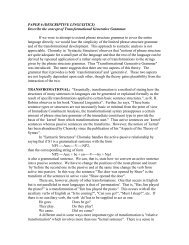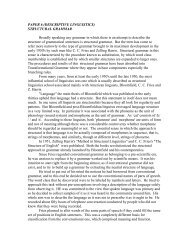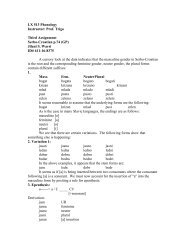PAPER 6 (DESCRIPTIVE LINGUISTICS ... - Jilani S. Warsi
PAPER 6 (DESCRIPTIVE LINGUISTICS ... - Jilani S. Warsi
PAPER 6 (DESCRIPTIVE LINGUISTICS ... - Jilani S. Warsi
Create successful ePaper yourself
Turn your PDF publications into a flip-book with our unique Google optimized e-Paper software.
a syllable and each movement of the chest is called a `chest pulse'. Occasionally a chest<br />
pulse is produced by greater muscular effort. This is called a `reinforced chest pulse'<br />
which produces a stressed syllable. For example, the English word `accident' has three<br />
syllables / k-si-dent/ and the first syllable is stressed while the rest of the two syllables<br />
are unstressed. And it is on the arrangement of stressed and unstressed syllables and the<br />
way they follow one another that the rhythm of a language depends.<br />
The syllable can be analyzed in terms of its elements or segments, also called<br />
speech sounds. These segments fall into two classes: vowels and consonants. In other<br />
words, a syllable is made up of one or more speech sounds. For example, the first<br />
syllable ta /tei/ of the word `table' has two speech sounds - a consonant /t/ and a vowel<br />
/ei/.<br />
As a syllable is produced by a chest pulse, there must be a free and unrestricted<br />
passage during, at least, a part of the production of the syllable. And it is during this part<br />
of the syllable that a vowel is produced. It carries the chest pulse and is the nucleus or<br />
the central part of the syllable. On the other hand, a consonant is marginal, that is, it<br />
occurs either at the beginning or at the end of a syllable, or both at the beginning and at<br />
the end. A consonant at the beginning of a syllable is called an `arresting consonant'.<br />
For example, the word `pick' consists of two marginal elements /p/, a releasing consonant<br />
and /k/, an arresting consonant and a nucleus /i/ which is a vowel.<br />
While describing the structure of syllables, we use the symbol C & V for a<br />
consonant and a vowel respectively. For example, the structure of the syllable /tei/ of the<br />
word `table' /teibl/ will be CV. It is also possible to have a cluster of two or more<br />
consonants before and/or after the nucleus as in the word `school' /sku:l/ i.e. CCVC.<br />
Some syllables are made up of nucleus alone as in `eye' or `I' /ai/. It has no consonant or<br />
vowel before it.<br />
A syllable which is arrested by a consonant is called a `closed syllable' and one<br />
which has no arresting consonants is called an `open syllable'.<br />
It is on the basis of the number of syllables that the words are classified into<br />
monosyllabic, disyllabic and polysyllabic, consisting of one, two and many syllables<br />
respectively. Sometimes two syllables in a word may be fused into one by suppressing a<br />
vowel sound in pronunciation, i.e. wa-t (e) ry, lit (e) ral. This process is known as<br />
`elision' or `slurring'.<br />
<strong>PAPER</strong> 6 (<strong>DESCRIPTIVE</strong> <strong>LINGUISTICS</strong><br />
SUPRASEGMENTAL PHONEMES<br />
The phenomena of segmentation of consonants and vowels may be important in<br />
the analysis of the sound system of a language. Stress and pitch differences, for example,<br />
might result in difference of meaning. In one dialect of Chinese [ma] with a high-level<br />
pitch means `mother', but [ma] with a low and mainly level pitch means `horse'. We must<br />
therefore say that in this dialect of Chinese, pitch is phonemic because we have a<br />
minimal pair, just as `bit' and `pit' are minimal pair in English. In English, pitch





